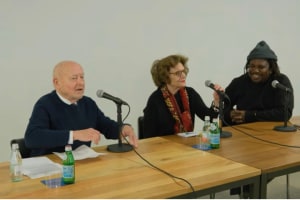
James Rosenquist
The Holy Roman Empire through Checkpoint Charlie
January 16 – May 24, 2024
Castelli Gallery is pleased to present James Rosenquist, The Holy Roman Empire through Checkpoint Charlie. Nearly forty feet long, Rosenquist’s painting The Holy Roman Empire through Checkpoint Charlie, 1994, encompasses his commentary on both history and politics. This monumental work was first exhibited at Leo Castelli Gallery in October 1994.
The Holy Roman Empire through Checkpoint Charlie is a monumental painting, spanning nearly forty feet. It combines figurative and semi-abstract painted images, the use of an actual object affixed to the canvas, and another leaning against it. James Rosenquist, who always followed the worldwide news, was shocked by how gray the East appeared in contrast to the colorful West. The painting is the first of a group of paintings that the artist made which address the Cold War and the idea of division.
The center of the painting is dominated by a large and intense red eye. While it is impossible to know what the eye stands for, after consulting sources made available from the archive of the artist, it may symbolize the relation to the Russian occupation zone in East Germany at the end of War World II.
In the left area of the painting is a sizable image of a what at first glance looks like a knight on a horse, moving triumphantly, and partially disappearing through a landscape of trees. In reality, this image depicts King Frederick the Great, under whose leadership Prussia became one of the greatest states in world history. The image is taken from the Daniel Rauch sculpture Equestrian Statue of Frederick the Great, 1851, located on the Unter den Linden, named for linden, or lime trees, the avenue in Berlin which was the main focal point of social and cultural life before World War II.
On the right side of the painting, Rosenquist has drawn the figures from Nike Instructs the Boy in Heroic History, Emil Wolff’s 1847 sculpture located on the Schloßrücke, a bridge in the central Mitte district of Berlin. Nike, the Greek goddess of victory, is showing the young boy the names of the “Great” victorious generals of the past: Alexander III, Julius Caesar, and Frederick II. While it is an edifying image, one is struck by the artist’s decision to depict Nike’s wings on fire, alluding to the tragedy these conquerors brought with them. Rosenquist’s mounting of a burnt piece of wood onto the canvas creates a dichotomy between the pretend, painted fire and the actual object destroyed by it.
On the right edge of the canvas is a column taken from the Brandenburg Gate, originally commissioned by Frederick the Great in the 1700s. Surprisingly, Rosenquist breaks from the linear composition of the canvas and instead shapes the bottom of the canvas to simulate the shape of the column’s pedestal, which gives the impression of being in front of the actual column and looking at it from below. This reference to the Brandenburg Gate symbolizes the division between East and West, or perhaps as a sign of future accord.
Rosenquist breaks away from traditional painting by adding an actual object, a small-scale ladder, which leans against the painted column. The size of the ladder exemplifies Rosenquist’s use of perspective as it is minute in comparison to the column and the immense size of the artwork. It is indeed the size that makes us see the ladder as unreal, an allegory for crossing from East to West or even actually attempting it, should one have acquired the tools to do so. The ladder portrays a final moment of negativity seen throughout the artwork, yet also suggests there may be a small glimmer of hope.
For further information, please contact Chloe Greisman at chloe@castelligallery.com.




